ISSN ONLINE(2278-8875) PRINT (2320-3765)
ISSN ONLINE(2278-8875) PRINT (2320-3765)
| Ponmozhi.G and Mr.L.Bala kumar, M.tech Department of Electrical and Electronics Engineering, Saveetha Engineering College, Chennai, India |
| Related article at Pubmed, Scholar Google |
Visit for more related articles at International Journal of Advanced Research in Electrical, Electronics and Instrumentation Engineering
The widespread application of Renewable Energy Sources (RES) requires centralized monitoring and controlling System. To make these operations control room independent, there is need to develop smart servers and web based applications. Cost is an essential factor of any embedded system design. This project discusses a novel concept of designing of cost effective server/client embedded system Renewable Energy sources. Here embedded server is developed with ARM9 controller loaded with Embedded Linux operating system. Low cost client are designed using arm7microcontroller with LAN connection. Server/client are connected in LAN system and server based applications has been developed to monitor/ controlling the client operation. The server has web based applications that can be accessed via internet. It consists of subsystems as server and multiple clients. Client embedded system is directly connected to the individual renewable sources which driving certain applications. Server embedded system is central system connected to various clients through Local Area Network. This server system monitors & controls the operation of all clients. The server operation can be monitored & control through web from any internet based computer. This gives facility to administrator to control the operation of client from any corner of world & he need not required to be at control station were server is resided.
Keywords |
| Renewable Energy Sources (RES), Boost-Up Converter, LPC2378 Microcontroller, RJ 45, Samsung, Matlab, 10Base-T |
INTRODUCTION |
| In the past century, it has been seen that the consumption ofnon-renewable sources of energy has caused moreenvironmental damage than any other human activity.Electricity generated from fossil fuels such as coal andcrude oil has led to high concentrations of harmful gases in the atmosphere. This has in turn led to many problems being faced today such as ozone depletion and global warming.Therefore, alternative sources of energy have become very important and relevant to today’s world. These sources, such as the sun and wind, can never be exhausted and therefore are called renewable. The System that converts electrical energy from these sources is called Renewable Energy System. Renewable energy is energy which comes from natural resources such as sunlight, wind, rain, Tides (Sea Waves) & geothermal heat (Heat Generated from Earth). All systems are remotely placed and generate power that stores in Battery. As generation and consumer systems are remotely placed, hence they need to monitor and have centralized control system. Development of an embedded system is need to today’s word due to characteristics of embedded system like low cost, low power consumption, small size etc. Development of embedded system for the renewable energy source which is distributed at various locations is a challenging task for developer. |
| Ethernet embedded system using ARM controller is presented by some authors. Here they discuss about designing of Ethernet system &their interfacing with ARM based controller. The author had presented an implementation of a platform independent embedded web server and its integration. Through introducing web into control network, that was possible to break through the spatio-temporal restriction of traditional control network and effectively achieve remote sensing, monitoring and real-time controlling for equipment. |
| Architecture of embedded remote monitoring system based on Internet has some of the key problems. They suggested that use of Java Applet for dynamic page design improved response capability. The embedded web server was designed and built as an expansion module for one of the nodes in the wireless sensor network (WSN). That allows authorized Internet users to establish two-way communication with the sensor network. The server uses limited available hardware resources to implement an interface to the WSN node and to serve dynamic HTML pages to the remote user. That was allows the user to monitor the operation of the WSN remotely, to periodically download the sensed data, and to change the operation mode of the network. Here discussed about how to design web server & for designing web server JAVA language is used. Also they had discuss of about problem related to renewable energy resources how the data related to renewable energyresources is monitor & how it is collected in centralized server. |
| An internet based embedded network monitoring system is proposed for renewable energy systems. By using a low cost network communication module (RCM 3700) as a web server, one can achieve better network security, lower power consumption, compact size, and easier to use as compared with a PC based one. |
HARDWARE |
| A. LPC2378 |
| LPC2378 is a 16/32 bit ARM7TDMI-S with 512K Bytes Program Flash, 16K Bytes RAM, EXTERNAL MEMORY BUS, RTC, 4x 10 bit ADC 2.44 uS, 2x UARTs,4x CAN, I2C, SPI, 2x 32bit TIMERS, 7x CCR, 6x PWM, WDT, 5V tolerant I/O, upto 60MHz operation. It has standard JTAG connector with ARM 2x10 pin layout forprogramming/debugging with ARM-JTAG. There is an Optional - TRACE connector and it is 128x128 pixel 12 bit color TFT LCD with backlight. It supports Ethernet 100MBit. It has MMA7620 3 axis accelerometer, two RS232 port, two CAN drivers and connector, SD/MMC card connector, UEXT connector with I2C, SPI, RS232 and power supply for connecting add-onmodules like RF link, MP3, etc, IrDA transceiver on board, Audio in and Audio Out jacks for microphone and headphones, trimpot connected to ADC, RESET circuit with external control of Philips ISP utility via RS232 port, Jumpers for ISP/RUN mode, Joystick with four directions and push action, two USER button, RESET Button, two on board voltage regulators 3V and 5V with up to 800mA current. |
| B. Samsung S3C2440 ARM9 |
| An application processor, or SoC (System on a Chip), is a microprocessor with a specialized architecture for deployment in embedded systems, such as digital still/video cameras, digital/smart TVs and set-top boxes, and automotive systems, among others. AnSoC operates at frequencies from several hundred MHz to a few GHz, and is architected to deliver significant computing performances at low power consumption levels in limited board spaces. High-end SoCs often contain multiple cores, enabling them to deliver exceptional performances in applications such as digital imaging and multimedia devices. The ARM core series is 920T. Its speed is 300MHz/400MHz. Its feature is 2410s feature + camera interface. |
| C. Solar Panel |
| A solar panel is a set of solar photovoltaic modules electrically connected and mounted on a supporting structure. A photovoltaic module is a packaged, connected assembly of solar cell. The solar module can be used as a component of a larger photovoltaic system to generate and supply electricity in commercial and residential applications. Each module is rated by its DC output power under standard test conditions (STC), and typically ranges from 100 to 320 watts. The efficiency of a module determines the area of a module given the same rated output - an 8% efficient 230 watt module will have twice the area of a 16% efficient 230 watt module. A single solar module can produce only a limited amount of power; most installations contain multiple modules. A photovoltaic system typically includes a panel or an array of solar modules, an inverter, and sometimes a battery and/or solar tracker and interconnection wiring. |
| D. Solar Radiation |
| The efficiency of a PV device depends on the spectral distribution of the solar radiation. The Sun is a light source whose radiation spectrum may be compared to the spectrum of a black body near 6000 K. A black body absorbs and emits electromagnetic radiation in all wavelengths. The theoretical distribution of wavelengths of the black body radiation is mathematically described by Planck’s law, which establishes the relations and interdependencies of the wavelength (or frequency), the temperature and the spectral distribution of the black body .Fig.4.1 shows the spectral distribution of the black body radiation compared with the extraterrestrial and terrestrial solar radiations .The study of the effect of the solar radiation on PV devices is difficult because the spectrum of the sunlight on the Earth’s surface is influenced by factors such as the variation of the temperature on the solar disc and the influence of the atmosphere in the extraterrestrial space, at the average distance between the Sun and the Earth, the irradiated solar energy is about 1.353 kW/m2 . On the Earth’s surface, the irradiation is approximately 1 kW/m2 (this is a reference value only, as the net irradiation on Earth’s surface depends on many factors). |
| E. Repeater Hubs |
| A repeater hub can connect multiple interfaces and helps to ensure reliable communications by detecting collisions, regenerating missing preamble bits,and blocking traffic from failed interfaces. The IEEE 802.3 standard specifies the functions of repeater hubs that support a single speed but doesn’t forbid hubs that support multiple speeds. On receiving traffic from an interface, the repeater hub repeats the traffic, passing it to each of the other attached interfaces. In a network that uses repeater hubs, each interface sees all of the traffic from the other interfaces, with two exceptions. Repeater hubs block traffic from failed interfaces. And a multi-speed hub may convert between speeds only when necessary. |
DESIGN OF REMOTE MONITORING SYSTEM |
| It consists of sub-systems as server and multiple clients. Client embedded system is directly connected to the individual renewable sources which driving certain applications. Server embedded system is central system connected to various clients through Local Area Network. This server system monitors & controls the operation of all clients. The server operation can be monitored & control through web from any internet based computer. This gives facility to administrator to control the operation of client from any corner of world & he need not required to be at control station were server is resided.The function of Web-based equipment monitoring system is to collect real-time data information of the on-site equipment, publish it through a Web form, and remote send the data in the form of the user-defined data transmission style. It should provide flexible rich remote monitoring and diagnosis function combining the configuration software based on standard browser.Monitoring system includes the basic functions as follows |
| F. DYNAMIC PUBLISHING REAL-TIME DATA |
| The embedded Web server publishes and dynamic refresh the real-time data and historical data in Web page form. Remote clients browse the Real-time information through network. |
| G. REMOTE PARAMETER SETTING |
| The parameters include operating and equipment condition parameters. The Web server executes the writing operation after received the parameters setting request from remote clients. The control functions include remote measurement, remote regulation, remote control and remote communication. After received the remote control operation request, The Web server order the control command to drive the corresponding implementing agencies of monitoring system.The document refers to the configuration parameters information of system and modules. The download function is the ability of download the parameters files from the Web server. The upload function is the ability of upload parameters files from the customer to the Web server.The monitoring system analyzes and processes the collecting data. It shows that the equipment is in abnormal condition if the data appears overrun and exception. In this time, the Web server send the corresponding alarm email automatically via network and notify the manager to maintenance the equipment timely. During designing alarm functions, their own characteristics and priority level of the monitored object should be considered. It should do the weighted processing of multi alarm signal to ensure that all important alarm can be handled in good time. In addition, during the system normal operation, it can send the system running log to the designated email address based on user’s setting.Access level setting is not only in the traditional page-based form, but also in the flexible Object-based form. A single device and data collection point may become the Object. Thus, different important levels data point can be configured of different access level in same Page. Only the client which has the access level no lower than the level equipment required can performance the monitoring operation within its limits after the authentication of web server. |
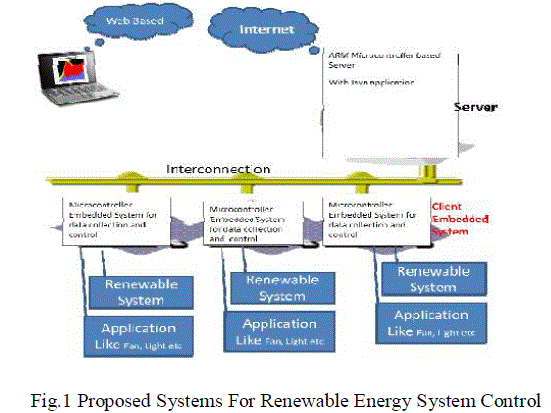 |
| Flexible query and rich report is expansion of the basic functions of the monitoring system. Giving the comparing analysis between real-time data and historical data, it can provide equipment operation and maintenance information for managers from different angles. It also can provide the reliable basis for equipment's maintenance, overhaul, renewal and transformation. |
| H. CLIENT EMBEDDED SYSTEM DESIGN |
| Client embedded systemhas design for followingapplications. Monitoring status of battery which is charging through solar system, monitor & control status of applications (Fan &Light), monitor Surrounding temperature, exchanging the information with server through Local Area Network |
| The connection diagram of renewable energy sources is shown in below figure. This block diagram clears that battery will be charge continuously through solar panel (one of the renewable energy source). Multiple applications like fan, light etc will be running on battery. The devices will be monitor and control by client embedded system, which is connected with the server. |
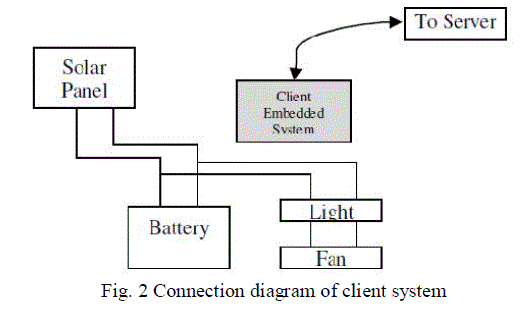 |
| It has four switch interfaces to selecting the program menu. Sense temperature and battery voltage 16X2 LCD display is interface to see the output of microcontroller. Multiple applications are interfaced through relay to the circuits (like Fan and Light control). The embedded system is designed around ARM7LPC2378 microcontroller. |
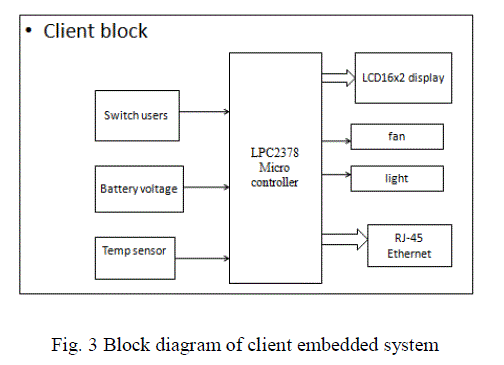 |
| I. THE STRUCTURE DESIGN OF REMOTE MONITORING SYSTEM |
| Remote monitoring system consists of the data acquisition equipment the local Web server and remote monitoring host. The embedded remote monitoring system completes the data collection in the embedded platform and provides the data to remote host through the TCP/IP protocol fromWeb server. It creates condition to realize unattended management. |
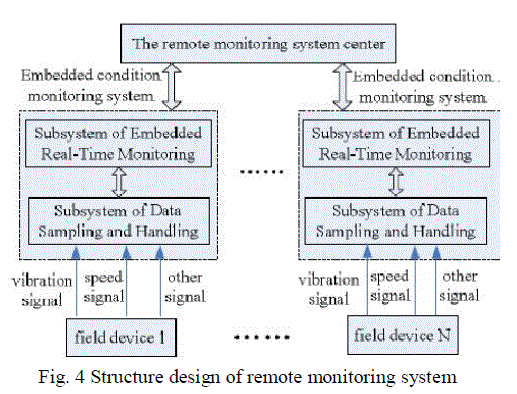 |
| The ARM9 core board consists of S3C2410, FLASH and SDRAM. Samsung's S3C2410 16/32-bit RISC is a microprocessor with the characteristics of high cost-performance, low power, small size and high integration. The S3C2410 developed using an ARM920T core.To reduce total system cost, the S3C2410 includes the following components: separate 16KB instruction and 16KB data cache, MMU to handle virtual memory management, LCD controller (STN&TFT), NAND flash boot loader and system manager. |
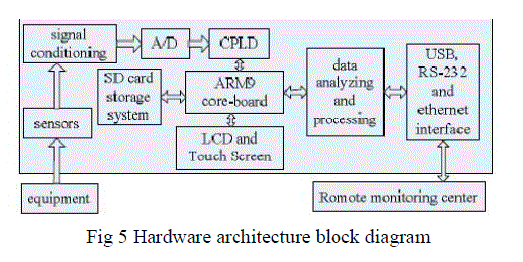 |
| The core board constructs flash memory system using the 28F128J3C chip which has 8 M×16 bit data widths. It constructs the SDRAM memory system using two HY57V561620BT chips which is 16bit data width and single-chip capacity of 32MB. The 64 MB SDRAM space can meet the requirements of embedded operating system and the various complex algorithm operations.The hardware platform extended a 10/100 adaptive Ethernet interface by connected a DM9000 chip which is an Ethernet MAC chip. The Platform also has two serial ports, USB HOST and USB DEVICE interface, audio interface, SD card interface and so on. The USB HOST interface can connect USB removable storage devices and other USB devices, such as USB mouse, USB keyboard. USB DEVICE interface can communicate with upper PC. For easy operation and debugging, Platform equips LCD and touch screen.The various signal of equipment are picked up by sensors and converted to digital signals by the A/D converter chip ADC0809 after Signal conditioning. The programmable control chip controls the A/D collection and the data transmission with ARM. The data can be published through web page form by embedded Web server, saved in SD card and displayed by LCD. For the purpose of providing equipment operating condition information facilitate, the system designed RS-232, USB and Ethernet data communication way. |
| This part can be embedded in the devices as an independent hardware module. It can collect equipment status information through A/D interface card, then establish the equipment running database records after analysis and processing. It sends alarm messages according to the equipment running status through the network and provides the function of historical data query and information document management. |
| J. THE DESIGN OF EMBEDDED WEB SERVER |
| The thinking of Web-based embedded equipment monitoring is to realize the HTTP service in the embedded equipment and transform the equipment to Web server to embed into controlled equipment. Through providing Web-based graphical management interface for the Internet or LAN users, it eliminated the special client management software and realized unified management of various equipments in the network. Through existing public communications networks, without geographical restrictions, using a standard Web browser, Users can directly access to the Web server in embedded devices and performance remote monitoring diagnosis and maintenance of all nodes on the network.Embedded system is a kind of special computer system which has limited resources and functions. To implement Web server in embedded system is characteristic of itself. Considering the need of large dynamic data exchange during equipment monitoring, using Samsung's S3C2410 as the platform, the paper proposed a solution to implement embedded Web server in the embedded Linux operating system environment. The solution takes the general Web design technique as foundation and combines embedded CGI (Common Gateway Interface), ActiveX and Java Applet technology. It can well meet the application requirements in the equipment monitoring domain. |
| K. EMBEDDED CGI |
| When http request URL is the external extended program, Web server puts the client side input's form data in the environment variable. And then server start external extended program to call the parameters of environment variable in the implementation process. The results will be returned to the Web server in HTML document form. This process exchanges data between Web server and external extended program.CGI is the standard of their dynamic interactive interface. According to CGI interface specification, the communication methods between application and Web server have environment variables, command line, the standard input and output. Different to standard CGI, the implementation of embedded CGI often aims at specific applications based upon the consideration of the characteristics of embedded systems. In the embedded Web based equipment condition monitoring system, CGI has two main functions: Implementation of user authentication security mechanism; when the user setting equipment control parameters (such as data acquisition parameters) through the browser, the parameters can be analyzed from http message and handled correctly. Because of the function be greatly simplified, the solution of embedded CGI has the following characteristics: it does not involve complicated process in the embedded CGI program, so it is no necessary to design it as a separate process. It is called as a sub-function of the HTTP request handling process. |
SIMULATION AND RESULTS |
| In the simulation part from the solar panel the dc battery will be charged and the dc voltage to step-up by using boost converter, there we are using an inverter to convert the dc voltage to ac voltage and then give to output of inverter to step up transformer with the help of matlab simulation. |
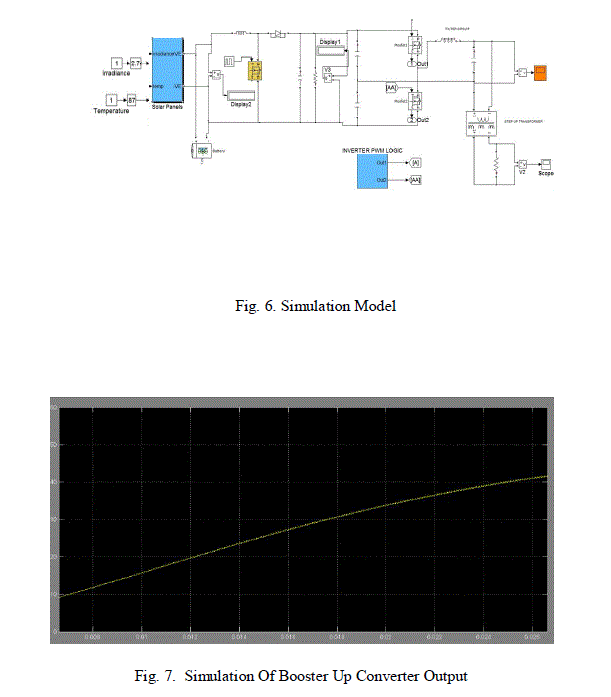 |
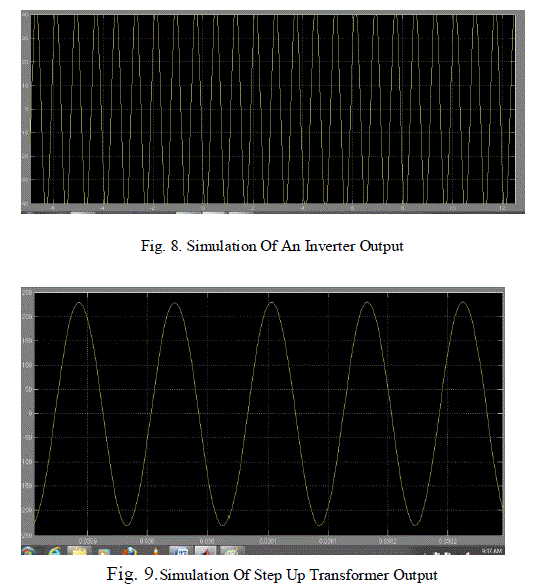 |
| The solar panel to give two inputs like as temperature and irradiance to produced the voltage and depends on it temperature. The solar panel output to stores on the battery and it capacity up to 7Am per hour. The solar output produced maximum12v. Due to minimum level of dc voltage we increased the voltage by using booster up converter, it booster up the voltage up to dc 80volts. Here to convert the dc voltage to ac voltage by using inverter process it makes the maximum level of ac voltage. An inverter output to give the input of the step up transformer and it produced the voltage normal ac supply. |
CONCLUSION AND FUTURE WORK |
| In this phase I have designed web based monitoring and controlling of client system which is having the solar energy resource. We drawn that power by using a buck boost converter and stored in a battery. Here we are having a inverter circuitry to convert it in to ac power. In our project I am monitoring all the input parameters like voltage, current, power etc and send it over the network .In this phase I have simulated a model of solar power source and read all the values of interest. In the second phase I am going to design the client server model for sending these parameter over the network to a remote destination. |
References |
|